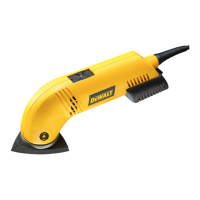8
ENGLISH
Date Code Position (Fig. A)
The date code
19
, which also includes the year of manufacture,
is printed into thehousing.
Example:
2019 XX XX
Year of Manufacture
Description (Fig. A)
WARNING: Never modify the power tool or any part of it.
Damage or personal injury couldresult.
1
On/off switch
2
Speed control dial
3
Sanding pad
4
Dust filter cassette
Intended Use
Your detail sander D26430 has been designed for quick sanding
of wood, metal and plastics in a professionalenvironment.
DO NOT use under wet conditions or in the presence of
flammable liquids orgases.
These sanders are professional powertools.
DO NOT let children come into contact with the tool.
Supervision is required when inexperienced operators use
thistool.
• Young children and the infirm. This appliance is not
intended for use by young children or infirm persons
withoutsupervision.
• This product is not intended for use by persons (including
children) suffering from diminished physical, sensory or
mental abilities; lack of experience, knowledge or skills
unless they are supervised by a person responsible for their
safety. Children should never be left alone with thisproduct.
ASSEMBLY AND ADJUSTMENTS
WARNING: To reduce the risk of serious personal
injury, turn tool off and disconnect tool from power
source before making any adjustments or removing/
installing attachments or accessories. Be sure the
trigger switch is in the OFF position. An accidental start-up
can causeinjury.
Fitting Sanding Sheets (Fig.B)
The tool uses hook and loop sandingsheets.
1. Place the tool on a table, sanding pad
3
up.
2. Place the sanding sheet
5
directly on top of the
sandingpad.
3. Hold the sanding pad with one hand and align the dust
extractionholes.
4. Press the sheet firmly onto the sandingpad.
Rotating the Sanding Pad (Fig.A)
The sanding pad is adjustable in 60°increments.
1. Hold the tool upsidedown.
2. Lift the sanding pad
3
up from thetool.
3. At the same time, rotate the sanding pad in the
desireddirection.
4. Release the sandingpad.
5. Move the sanding pad back and forth slightly until it
engages inposition.
Mounting the Louvre Attachment (Fig.C)
Fitted with sanding sheets on both sides, the louvre attachment
is used to sand crevices. The louvre attachment is available as
anoption.
1. Place the tool on a table, sanding pad
3
up.
2. Loosen the screw
7
and remove it using the hex
keyprovided.
3. Remove the spring
8
from the recess in the sandingpad.
4. Remove the sandingpad.
5. Locate the louvre attachment
9
so that it engages in
position and cannot beturned.
6. Place the spring
8
in therecess.
7. Fit the screw
7
and tightenit.
Setting the Electronic Speed Control Dial
(Fig.D)
The speed is infinitely variable from 14000–22000 min
-1
using
the electronic speed control dial
2
.
1. Turn the electronic speed control dial to the required level.
The correct setting, however, is a matter ofexperience.
2. Generally, harder materials require a highersetting.
Dust Extraction (Fig. E–G)
WARNING: Since woodworking with a sander produces
dust, always install a dustbag designed in compliance
with the applicable directives regarding dustemission.
WARNING: Do not use a dustbag or vacuum extractor
without proper spark protection when sandingmetal.
1. Slide a dust filter
10
into the cassette
4
asshown.
2. Fit the cover
11
onto thecassette.
3. Attach the cassette
4
to the dust extraction outlet
12
.
4. Push the cassette firmly until it locks inposition.
Fitting the Dust Extraction Adaptor (Fig.G)
The dust extraction adaptor
13
is available as anoption.
1. Remove the dust filter cassette, iffitted.
2. Attach the adaptor
13
to the dust extraction outlet
12
.
3. Pass the screw
14
through the adaptor outlet
15
into the
mounting hole
16
. Tighten thescrew.
4. Connect the hose of a suitable dust extraction system to
theadaptor.
5. Alternatively, when no dust extration is required, place the
end cap
17
on the adaptor outlet
15
.

